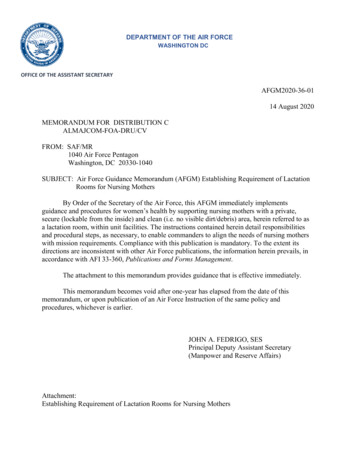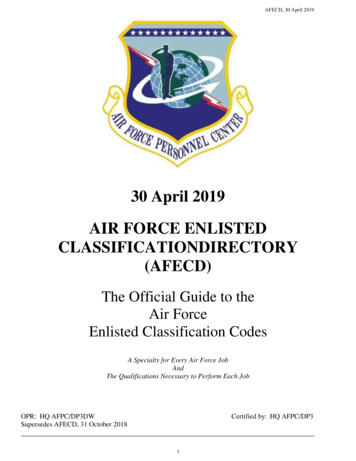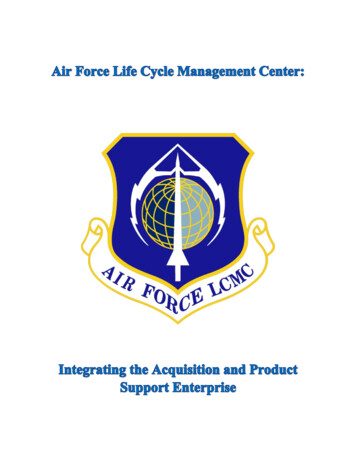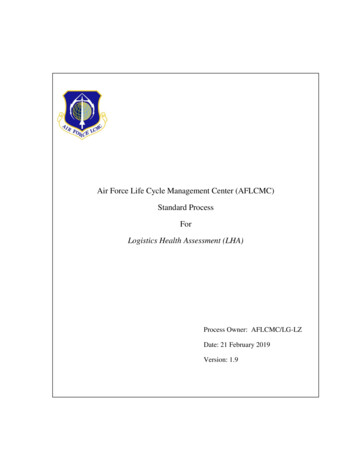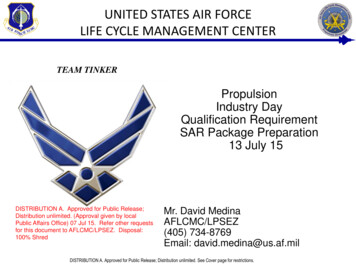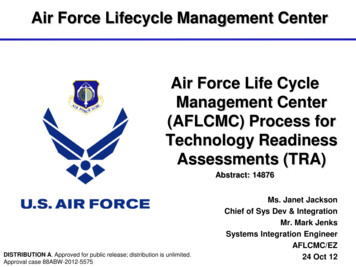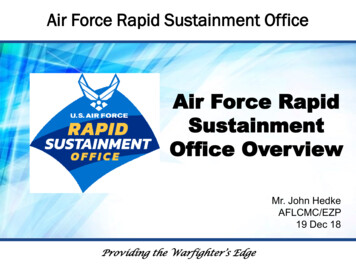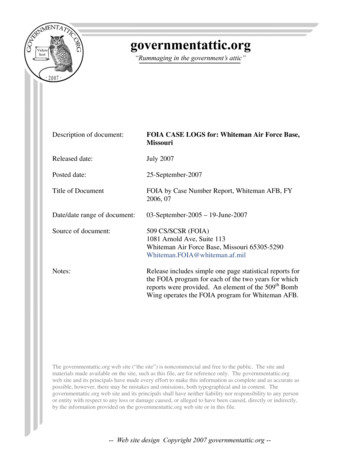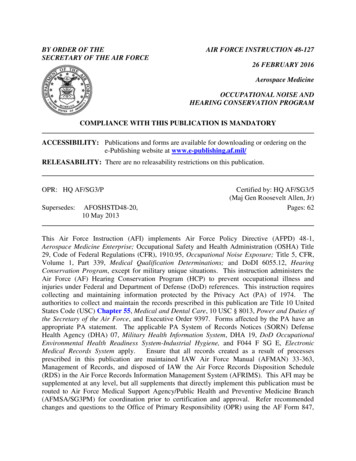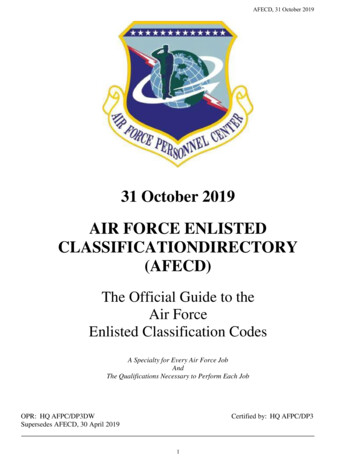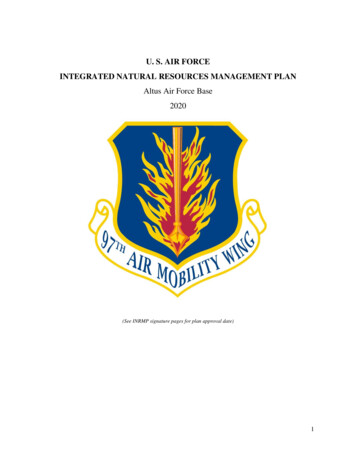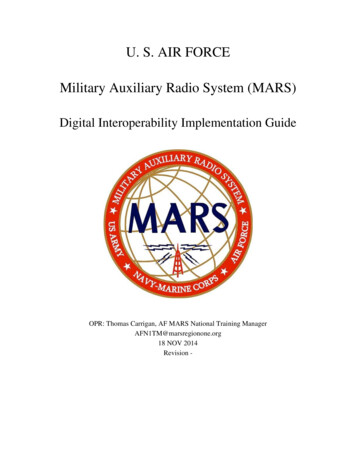
Transcription
U. S. AIR FORCEMilitary Auxiliary Radio System (MARS)Digital Interoperability Implementation GuideOPR: Thomas Carrigan, AF MARS National Training ManagerAFN1TM@marsregionone.org18 NOV 2014Revision -
U.S.A.F MARSDigital InteroperabilityImplementation Guide18 NOV 2014 RevREVISION PAGEREVISIONDATE18 NOV 2014iDESCRIPTIONInitial Release
U.S.A.F MARSDigital InteroperabilityImplementation Guide18 NOV 2014 RevTABLE OF CONTENTS1INTRODUCTION . 11.1 ASSUMPTIONS. 11.2 REQUIREMENTS . 11.3 CONVENTIONS USED IN THIS GUIDE . 21.3.1 Call Signs .21.3.2 Routing Indicators .21.3.3 Encryption .22REFERENCE DOCUMENTS . 33RECOGNITION OF DIGITAL MESSAGE FORMATS AND PROCEDURES. 43.1 BRIEF OVERVIEW OF DIGITAL MESSAGE TYPES . 43.2 RECOGNIZING ACP-126 PLAINDRESS MESSAGES. 43.3 RECOGNIZING ACP-127 (US SUPP 1K) PLAINDRESS MESSAGES. 53.4 MESSAGES WITH ENCRYPTED TEXT . 63.5 RECOGNIZING CODRESS MESSAGES . 84SIMPLE RELAY OF MESSAGES. 104.1 STEP 1. VERIFY THAT THE MESSAGE WAS RECEIVED CORRECTLY. . 104.1.1 Verifying Reception Of Plain Language Messages . 114.1.2 Verifying Reception Of Encrypted Messages . 114.2 STEP 2. EDIT LINE 1 TO INDICATE YOUR STATION AND SERIAL NUMBER . 124.3 STEP 3. COPY AND PASTE MESSAGE INTO MS-DMT TRANSMIT PANEL . 125ACP-127 MESSAGE PROCEDURE . 135.1 ROUTING INDICATOR PLAN. 135.2 ACP-127 DETAILS . 135.2.1 Format Line 1 - Transmission Identification . 145.2.2 Format Line 2 - Precedence and Routing Indicator For Message Being Sent . 155.2.3 Format Line 3 - Sending Station’s RI, Serial Number and Filing Time . 155.2.4 Format Line 4 - Transmission Instructions . 165.2.5 Format Line 5 - Precedence and Date Time Group. 175.2.6 Format Line 6 - Plain Language Address OR Routing Indicator of the Originator175.2.7 Format Line 7 - BOTH The Routing Indicator AND Plain Language Address of theAddressee separated by (/) . 175.2.8 Format Line 8 - INFO addressee(s) . 185.2.9 Format Line 9 - Exemptions . 185.2.10 Format Line 10 - Group Count . 185.2.11 Format line 11 - Break . 185.2.12 Format Line 12 - Message text. 185.2.13 Format Line 13 - Break . 195.2.14 Format Line 14 - (omitted deliberately, not normally used). 195.2.15 Format Line 15 - Serial Number . 195.2.16 Format Line 16 - End of Message Indicator . 196ACP-127 CODRESS MESSAGE . 20ii
U.S.A.F MARSDigital InteroperabilityImplementation Guide18 NOV 2014 Rev6.1 ACP-127 CODRESS PROCEDURE . 206.1.1 ACP-127 CODRESS Format Lines 1, 2, and 3. 206.1.2 ACP-127 CODRESS Format Line 4 . 216.2 ACP-127 CODRESS FORMAT LINE 5 . 216.2.1 ACP-127 CODRESS Format Lines 6, 7, 8 and 9 . 216.2.2 ACP-127 CODRESS Format Line 10. 216.2.3 ACP-127 CODRESS Format Line 11. 216.2.4 ACP-127 CODRESS Format Line 12. 226.2.5 ACP-127 CODRESS Format Line 13, 14, 15, and 16 . 227U. S. MESSAGE TEXT FORMAT (USMTF) . 248MARS OFF-LINE TRANSEC . 259AUTOMATED MESSAGE TERMINAL (AMT) . 26LIST OF FIGURESFigure 3-1 ACP-126 PLAINDRESS Message Sample . 4Figure 3-2 ACP-126 PLAINDRESS Message Sample (Produced by AMT) . 4Figure 3-3 Sample ACP-127 PLAINDRESS Message Using Simulated Routing Indicators . 5Figure 3-4 Sample ACP-127 PLAINDRESS Message Using Plain Language Address (PLA). 6Figure 3-5 Example of an ACP-126 PLAINDRESS Message with Encrypted Text . 7Figure 3-6 Example of an ACP-127 PLAINDRESS Message with Encrypted Text . 7Figure 3-7 Example of an ACP-127 CODRESS Message . 8Figure 4-1 Example of a Received CODRESS Message With Errors. 10Figure 5-1 Example of ACP-127 PLAINDRESS Message Components Showing Format Lines(FL) to the Left. 14Figure 6-1 Example of a Complete ACP-127 CODRESS Message (Code Groups Are SimulatedAnd Do Not Actually Decrypt) . 23Figure 7-1 Example of a USMTF Message . 24iii
U.S.A.F MARSDigital InteroperabilityImplementation Guide18 NOV 2014 Rev-FM:TO:DT:THOMAS CARRIGAN/ AFN1TMAF MARS NATIONAL TRAINING MANAGERALL AF MARS MEMBERS15 NOV 2014SUBJ: TRANSMITTAL - DIGITAL INTEROPERABILITY IMPLEMENTATION GUIDEMANY AIR FORCE MARS MEMBERS HAVE EXPRESSED CONCERNS ABOUTTHE VOLUME OF NEW INFORMATION BEING PRESENTED TO THEM IN RECENTMONTHS RELATED TO INTEROPERATING WITH OTHER MARS SERVICES, USINGTHE DIGITAL MODE REFERED TO AS MIL-STD M110A, USING UNFAMILIARMESSAGE PROCEDURES SUCH AS ACP-127, ENCRYPTION, AND USMTF MESSAGEFORMATS. SEVERAL HAVE COMMENTED THEY FEEL OVERWHELMED ANDCONFUSED AND DON'T KNOW HOW TO BEGIN TO PROCESS ALL THE NEWINFORMATION.THIS GUIDE IS WRITTEN FOR THOSE MEMBERS. THIS GUIDE IS NOT ASUBSTITUTE FOR OTHER TRAINING DOCUMENTS AND REFERENCE MATERIALS.RATHER, IT IS INTENDED TO HELP MEMBERS WITH A PLAN OF WHAT TO DOFIRST, WHAT TO DO NEXT, ETC. IT DOES CONTAIN AN EXPANSIVE EXPLANATIONOF ACP-127 MESSAGE PROCEDURES BECAUSE IT WILL TAKE SOME TIME FOR AMORE COMPREHENSIVE MANUAL CONTAINING THAT SUBJECT TO BE PREPARED.NO ONE EXPECTS MARS MEMBERS TO MASTER THESE SUBJECTSINSTANTANEOUSLY. WE ARE ALL ENGAGED IN A PROCESS OF LEARNING HOWTO USE THESE TECHNOLOGIES AND PROCEDURES TO SUPPORT OUR MISSION OFPROVIDING CONTINGENCY COMMUNICATIONS TO THE DEPARTMENT OFDEFENSE IN ACCORDANCE WITH DOD INSTRUCTION 4650.02. FURTHERMORE, WENEVER FINISH TRAINING. WE WILL ALL BE TRAINING CONTINUOUSLY AS LONGAS WE REMAIN IN MARS.I HOPE YOU WILL FIND THIS GUIDE HELPFUL. I ALSO HOPE THAT THOSEMEMBERS WHO BECOME MORE PROFICIENT AT USING THESE TECHNOLOGIESAND PROCEDURES WILL HELP OTHERS WHO NEED HELP. WE ARE ALL TRAINING1
U.S.A.F MARSDigital InteroperabilityImplementation Guide18 NOV 2014 RevAND WE CAN ALL BE TRAINERS. PLEASE DO KEEP YOUR TRAINING EFFORTSPOSITIVE AND SUPPORTIVE TOWARD OTHERS.IN PREPARING THIS GUIDE, I HAVE BENEFITTED FROM THE SUGGESTIONS,CRITICISM, AND IDEAS OF MANY MARS MEMBERS. I APPRECIATE ALL OF THATASSISTANCE. I AM ESPECIALLY APPRECIATIVE OF THE ASSISTANCE OF BRUCE,AFN4AA, FOR HIS HELP IN ASSEMBLING THE DOCUMENT INTO A PRESENTABLEMARS DOCUMENT.IF YOU HAVE COMMENTS CONCERNING THIS GUIDE OR ANY ASPECT OFTHE TRAINING PROGRAM, PLEASE FEEL FREE TO CONTACT ME ATAFN1TM[AT]MARSREGIONONE.ORG.V/RTOM CARRIGAN/AFN1TMAF MARS TRAINING MANAGER2
U.S.A.F MARSDigital InteroperabilityImplementation Guide18 NOV 2014 Rev-1 INTRODUCTIONWhile many MARS stations in all three service branches have developed the ability tohandle encrypted MIL-STD M110A (hereinafter, "M110A") traffic and send it by the routingsystem very proficiently, there are many others who are just getting started. This Guide is forthose who are getting started. It presents the essential information in a rational, manageableorder so that members don't feel they need to learn too many things all at once. It is alsointended that this Guide will address things in the order members will need them; first thingsfirst, not last things first. This Guide is, as one reviewer called it, a "roadmap." Specifically,this is the order in which to address things: Use of M110A to relay messagesACP-127 (Supp 1K) message formatUSMTFTRANSEC encryption toolAutomated Message Terminal (AMT)1.1 ASSUMPTIONSIt is assumed that the MARS member has a functioning MARS station and understandsproper net operations and discipline, and has been trained in PLAINDRESS message draftingand transmission by voice, all in accordance with the National Training Manual, AlliedCommunications Publications (ACP's) 121, 125 and 131. Recognizing that the comprehensivenature of each of these publications can make them difficult to work with, some basicinformation is provided in this Guide about ACP-127 message procedures to help members beable to work with these messages more quickly. This Guide, however, is not a substitute forstudying the more detailed treatment of this subject in the ACP's.This Guide does not instruct the operator on the hardware or software aspects of digitaloperation. It is assumed that the operator has obtained and installed the necessary hardware andsoftware requirements, as follows:1.2 REQUIREMENTSIn order to send and receive messages using MIL-STD M110A, each MARS member willneed a computer running a program to generate and interpret the M110A waveform digital modeof transmission using a sound card. This software is called MIL-STD Data Modem Terminal(MS-DMT) and is available at http://amtog.org/amt/ along with extensive documentation andinstructions for installation and operation of the software. Members will also need a radio, andan interface between the radio and computer. An interface that works for other "sound cardmodes," such as PSK, MT-63, Olivia, etc. is sufficient. This Guide will not detail how to obtain1
U.S.A.F MARSDigital InteroperabilityImplementation Guide18 NOV 2014 Revor connect those, but many MARS members can help. Note that the interface is a device thatpasses audio between the radio and computer, and triggers the transmitter; a "virtual modem."The interface needed is not a "hardware modem" such as a PK-232 or Kantronics KAM as usedby older digital modes such as packet and Pactor. Commonly used interfaces include theSignalLink , RigBlaster , among others. Software defined radios and military radios withbuilt-in modems may not need a separate interface.Another useful digital mode is MT-63, which is supported by several software suitesincluding Digital Master 780 and FLdigi , available on the web (http://www.w1hkj.com).These are the minimal requirements for a station to be able to send and receive digitalmessages that will be passed in joint operations. There are additional software requirements forencrypting and decrypting messages, and there is additional software, which can be helpful fordrafting messages. These additional requirements will be addressed in later sections. For now,let's keep things simple.1.3 CONVENTIONS USED IN THIS GUIDEThroughout this Guide, matters relating to information, which is For Official Use Only(FOUO), have been dealt with in a manner to avoid the disclosure of such FOUO informationand, thus, avoid the need for FOUO caveats for the entire Guide. Among the practices followedfor this purpose are the following conventions:1.3.1 Call SignsIn sample messages, all call signs are fictitious. In the event that a call sign used in asample message is an actual call sign assigned to an actual person or station, the use of that callsign in this Guide does not indicate that the sample message was actually sent by that person orstation and no endorsement by the same is implied or intended.1.3.2 Routing IndicatorsRouting Indicators, which are explained later in this text, are simulated by a string ofletters beginning with a percentage sign (%); e.g., %AAAAAA. For accurate information aboutrouting indicators, refer to the Joint MARS Routing Indicators, JM 2-203.1.3.3 EncryptionThroughout this text, wherever text is shown as encrypted, the encryption is simulated.Also, no specific mention is made of actual Z codes related to encryption in order to keep thoseout of the public domain. Placement of Z codes related to encryption is indicated by a simulatedZ code, "Zxz."2
U.S.A.F MARSDigital InteroperabilityImplementation Guide18 NOV 2014 Rev-2 REFERENCE DOCUMENTSa) ACP-121(I) Allied Communications Publication Communications Instructions General(October, 2010)b) ACP-125(F) Allied Communications Publication Communications InstructionsRadiotelephone Procedures (September, 2001)c) ACP-126(C) Allied Communications Publication Communications InstructionsTeletypewriter (Teleprinter) Procedures (May, 1989)d) ACP-127(G) Allied Communications Publication Communications Instructions TapeRelay Procedures (November, 1988)e) ACP-127(G) U. S. Supp-1(K) supplement to ACP-127(G) (November, 2007)f) ACP-127 Message Procedures - Expanded Training and Guidance, by Daniel Wolff, Jr.(25 Sep 2014)g) ACP-131(F) Allied Communications Publication Communications Instructions Operating Signals (April, 2009)h) Air Force MARS Training Manual 2013-10-31 Rev-AD (October 31, 2013)i) JM 2-203 Joint MARS Routing Indicators (October, 2014)j) AM 2-310 Army MARS Message and Report Forms (February, 2013)3
U.S.A.F MARSDigital InteroperabilityImplementation Guide18 NOV 2014 Rev-3 RECOGNITION OF DIGITAL MESSAGE FORMATSAND PROCEDURES3.1 BRIEF OVERVIEW OF DIGITAL MESSAGE TYPESThere are a number of different message procedures used in MARS. They are commonlyreferred to by reference to the Allied Communications Publication (ACP) that specifies thedetailed rules for each. Examples of each type are shown here only for purposes of recognition.No attempt is made here to detail every variable that can appear in each message type. Forcomplete details, see the ACP manual for the message type in question. All of the ACP Manualsreferred to in this Guide are available at www.marsregionone.org/Pubs.html, and should be inevery MARS member's possession. They are also available elsewhere on the Web by doing asearch through Google or Yahoo. The following is only to assist the reader with recognition ofvarious message forms. The forms include PLAINDRESS and CODRESS examples.Abbreviated PLAINDRESS samples are omitted for simplicity.3.2 RECOGNIZING ACP-126 PLAINDRESS MESSAGESThe ACP-126 message procedure was designed for teletype networks and can be used forkeyboard-to-keyboard (i.e., peer-to-peer) communications such as can be done within a state or aregion net. Samples of ACP-126 PLAINDRESS messages follow below in Figures 3-1 and 3-2.AFA1AA DE AFA1BB NR 002R 230023Z MAY 2014FM AFA1BBTO AFA1AABTUNCLASTEXT TEXT TEXTBTVZCZC1AA002AFA1AA DE AFA1BB NR 002R 230023Z MAY 2014FM AFA1BBTO AFA1AABTUNCLASTEXT TEXT TEXTBT[8 LINE SPACES][8 LINE SPACES]NNNNNNNNFigure 3-1 ACP-126 PLAINDRESSMessage Sample4Figure 3-2 ACP-126 PLAINDRESSMessage Sample (Produced by AMT)
U.S.A.F MARSDigital InteroperabilityImplementation Guide18 NOV 2014 RevFigure 3-1 is a "traditional" ACP-126 message as described in the ACP. Note that thereceiving station (AFA1AA) and the sending station (AFA1BB) are shown in the top line. Figure3-2 is an ACP-126 PLAINDRESS message as produced by the Automatic Message Terminal(AMT) program, which is described later in this text. Note that AMT has added a line ofcharacters at the beginning. ACP-126 messages are useful for intra-state and intra-regioncommunications and administrative messages. ACP-126 messages are not appropriate for outof-region traffic being sent over the Trans-Global net (J0G). The message elements in an ACP126 PLAINDRESS message are in an order very similar to an ACP-125 PLAINDRESS voicemessage and probably appear familiar to most AF MARS members.3.3 RECOGNIZING ACP-127 (US SUPP 1K) PLAINDRESS MESSAGESThe ACP-127 (US Supp 1K, hereinafter "ACP-127") message procedure is designed forforwarding by automatic systems over long distances. In order to accommodate the automatedequipment, a number of features were added to the message heading. These include an initialstring of characters (VZCZC) to signal the start of a message to the forwarding system, the use ofrouting indicators instead of, or in conjunction with, plain language addresses, an end oftransmission indicator (NNNN) and certai
Nov 18, 2014 · software requirements, as follows: 1.2 REQUIREMENTS In order to send and receive messages using MIL-STD M110A, each MARS member will need a computer running a program to generate and interpret the M110A waveform digital mode of transmission using a sound card. This

